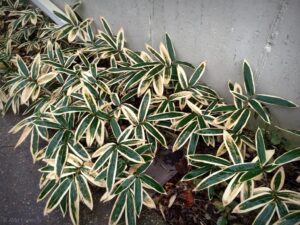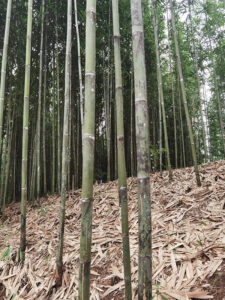
Gigantochloa apus, commonly known as string bamboo or tali bamboo, is one of the most useful bamboo species in tropical Asia. It is widely cultivated in Indonesia, Malaysia, and Thailand for its medium-sized culms, high flexibility, and strength. This species is especially popular in traditional crafts, furniture making, and light construction.
Because of its clumping nature and manageable size, Gigantochloa apus has become one of the most versatile and sustainable bamboo types in Southeast Asia.
Botanical Classification
- Scientific Name: Gigantochloa apus (Schult. f.) Kurz ex Munro
- Family: Poaceae (Grass Family)
- Subfamily: Bambusoideae
- Tribe: Bambuseae
- Common Names: String Bamboo, Tali Bamboo, Bamboo Rope
- Native Region: Southeast Asia (Indonesia, Malaysia, Thailand, and parts of China and India)
Morphological Characteristics
Gigantochloa apus is a clumping (sympodial) bamboo species that grows in tight clusters. It is medium-sized compared to giant species like Dendrocalamus asper but larger than ornamental bamboos.
Key Features:
- Height: 8–22 meters depending on growing conditions.
- Culm Diameter: 4–13 cm with wall thickness between 6–13 mm.
- Culm Color: Green to yellowish-green when mature; smooth surface with slight ridges at the nodes.
- Internode Length: 20–60 cm, typically straight and uniform.
- Leaves: Narrow and lanceolate, forming dense foliage on the upper part of the culm.
- Growth Habit: Clumping type with short rhizomes, non-invasive.
The plant’s combination of flexibility and tensile strength gives it the nickname “string bamboo,” as its fibers are used for weaving and rope-like crafts.
Habitat and Growing Conditions
Gigantochloa apus thrives in tropical and humid environments. It grows naturally in lowland areas and foothills, often near rivers or forest edges.
Ideal Growth Conditions:
- Climate: Warm and humid tropical climate
- Temperature Range: 20–35°C
- Altitude: Sea level up to 1,500 meters
- Rainfall: 1,200–2,500 mm per year
- Soil: Loamy or sandy soil with good drainage
The species is resilient to seasonal variations and adapts well to mixed agroforestry systems. Its clumping nature makes it ideal for managed plantations without the risk of invasive spreading.
Major Uses and Applications
1. Construction Material
The culms of Gigantochloa apus are commonly used in light construction. They are suitable for walls, partitions, ceilings, and roofing structures. The bamboo’s flexibility makes it resistant to bending and cracking, making it valuable in earthquake-prone regions.
2. Furniture and Handicrafts
Gigantochloa apus is one of the most important raw materials for the bamboo craft industry in Indonesia. Its long, smooth culms are easy to split into strips used for weaving baskets, mats, and furniture frames. The species is favored for creating decorative and functional bamboo furniture.
3. Rope and Binding Material
In local Indonesian languages, “tali” means rope or string. This bamboo is named “tali bamboo” because its fibers are long and strong, traditionally used for tying and binding in rural construction and farming.
4. Musical Instruments and Tools
The culms are sometimes used for musical instruments, fishing rods, or tools due to their elasticity and fine texture.
5. Environmental and Agricultural Use
Gigantochloa apus contributes to soil stabilization and erosion control through its dense root system. It also helps improve soil fertility and serves as a natural windbreak in agricultural fields.
Advantages
- Non-invasive: Clumping growth makes it easy to manage.
- Fast-growing: Reaches maturity in about 3–4 years.
- Strong and flexible: Suitable for both structural and decorative applications.
- Culturally significant: Used for centuries in traditional Indonesian and Malaysian architecture.
- Renewable resource: Harvesting does not kill the plant, allowing continuous regrowth.
Limitations and Challenges
- Moderate size: Not ideal for heavy-duty construction where large bamboo species are required.
- Durability: Untreated culms are vulnerable to pests and fungal attack; chemical or smoke treatment is recommended.
- Quality variation: Environmental factors can affect culm thickness and strength.
- Limited international awareness: Despite its high quality, it is less known outside Asia compared to larger species.
Cultivation and Propagation
Propagation of Gigantochloa apus is usually carried out through vegetative methods, as flowering and seed production are rare.
Propagation Methods:
- Culm cuttings: Sections of mature culms planted in moist soil.
- Rhizome division: Separation of young clumps from mother plants.
- Branch cuttings: Side branches with nodes used for rooting.
Once established, the plant requires minimal maintenance. Regular harvesting encourages new shoots, ensuring a continuous bamboo supply.
Environmental Importance
Gigantochloa apus contributes significantly to sustainable resource management and climate resilience. Its fast growth and carbon absorption capacity make it valuable for carbon sequestration projects. The plant also supports biodiversity by providing habitat for small animals and insects.
In community forestry, this bamboo species helps provide income, materials, and ecological balance in rural areas.
Conclusion
Gigantochloa apus stands out as a medium-sized, strong, and flexible bamboo species that plays a vital role in Southeast Asian culture and economy. It bridges the gap between giant bamboos used for construction and smaller species used for crafts.
With its wide range of applications from furniture and weaving to sustainable architecture Gigantochloa apus represents a perfect balance between practicality and ecological value. Its non-invasive growth, fast regeneration, and renewability make it a key species for sustainable development and green design.






